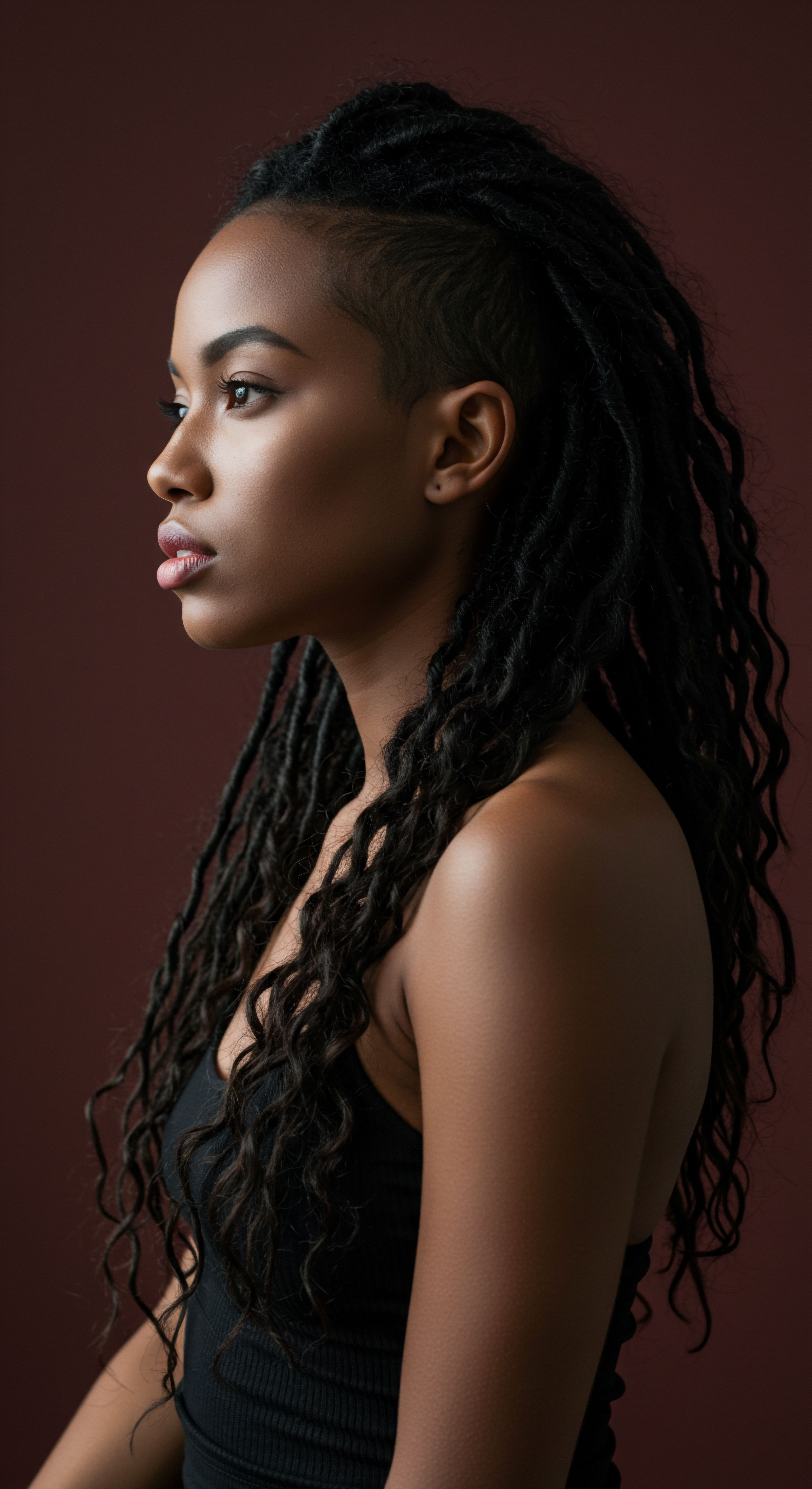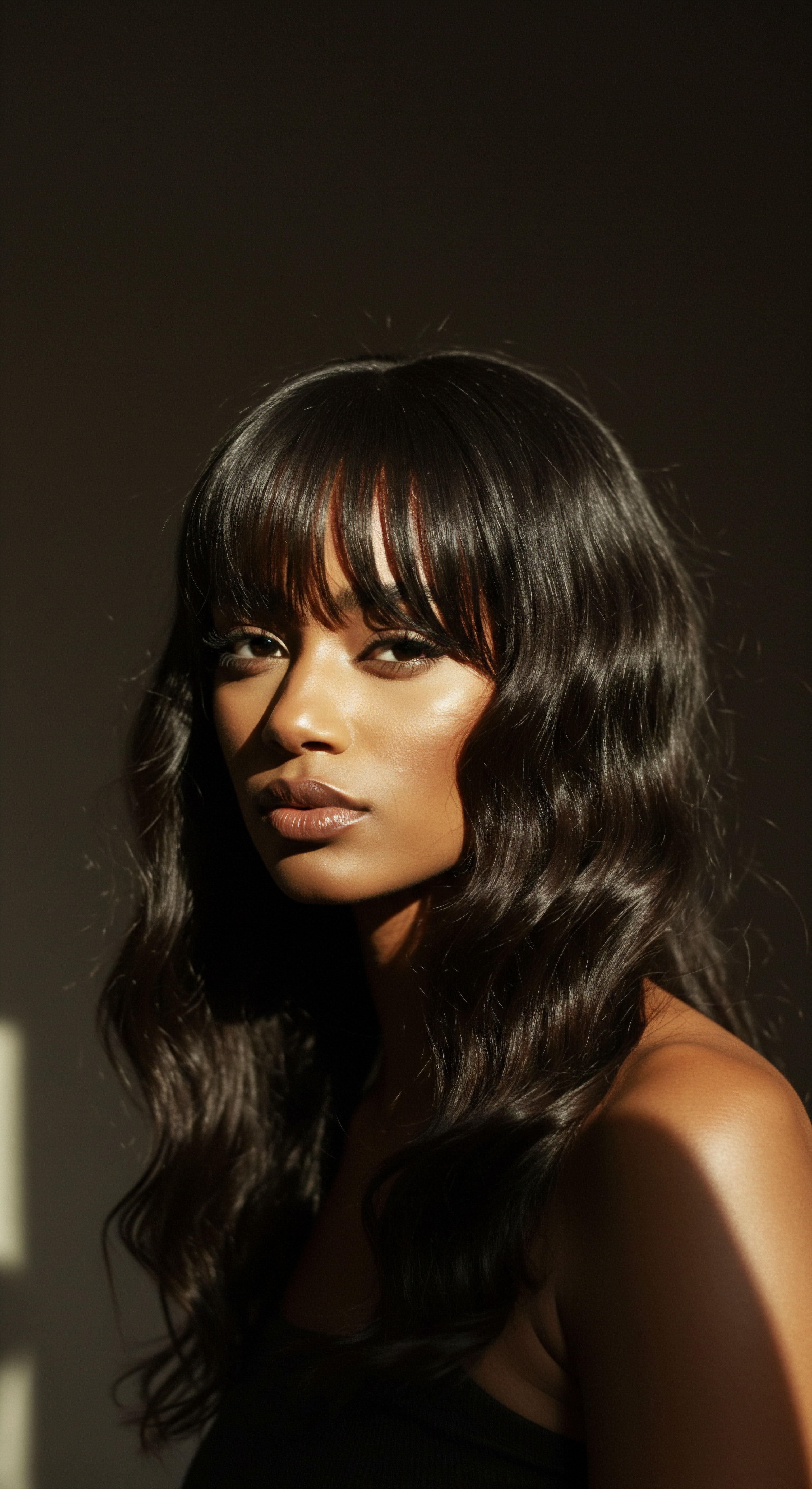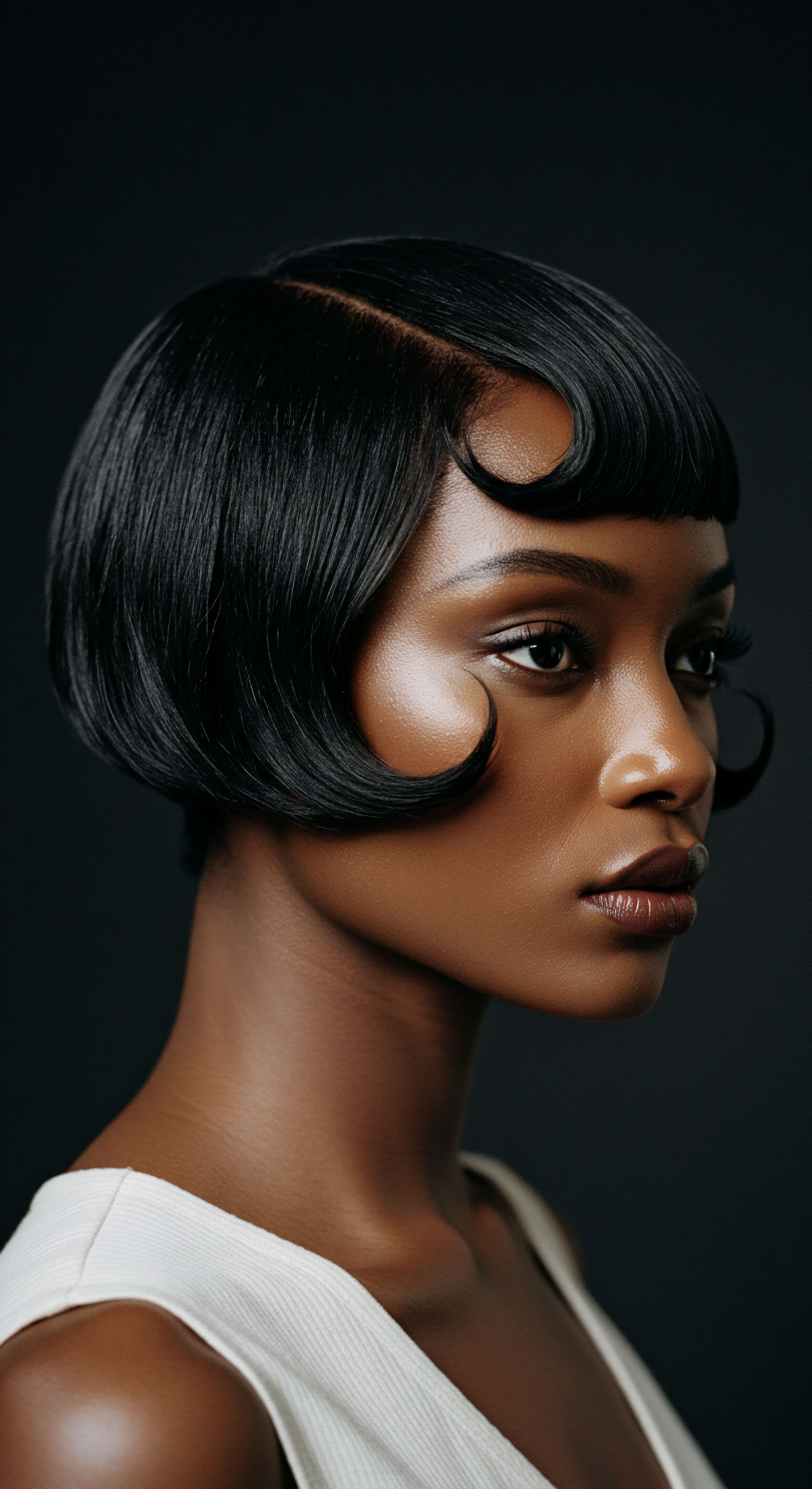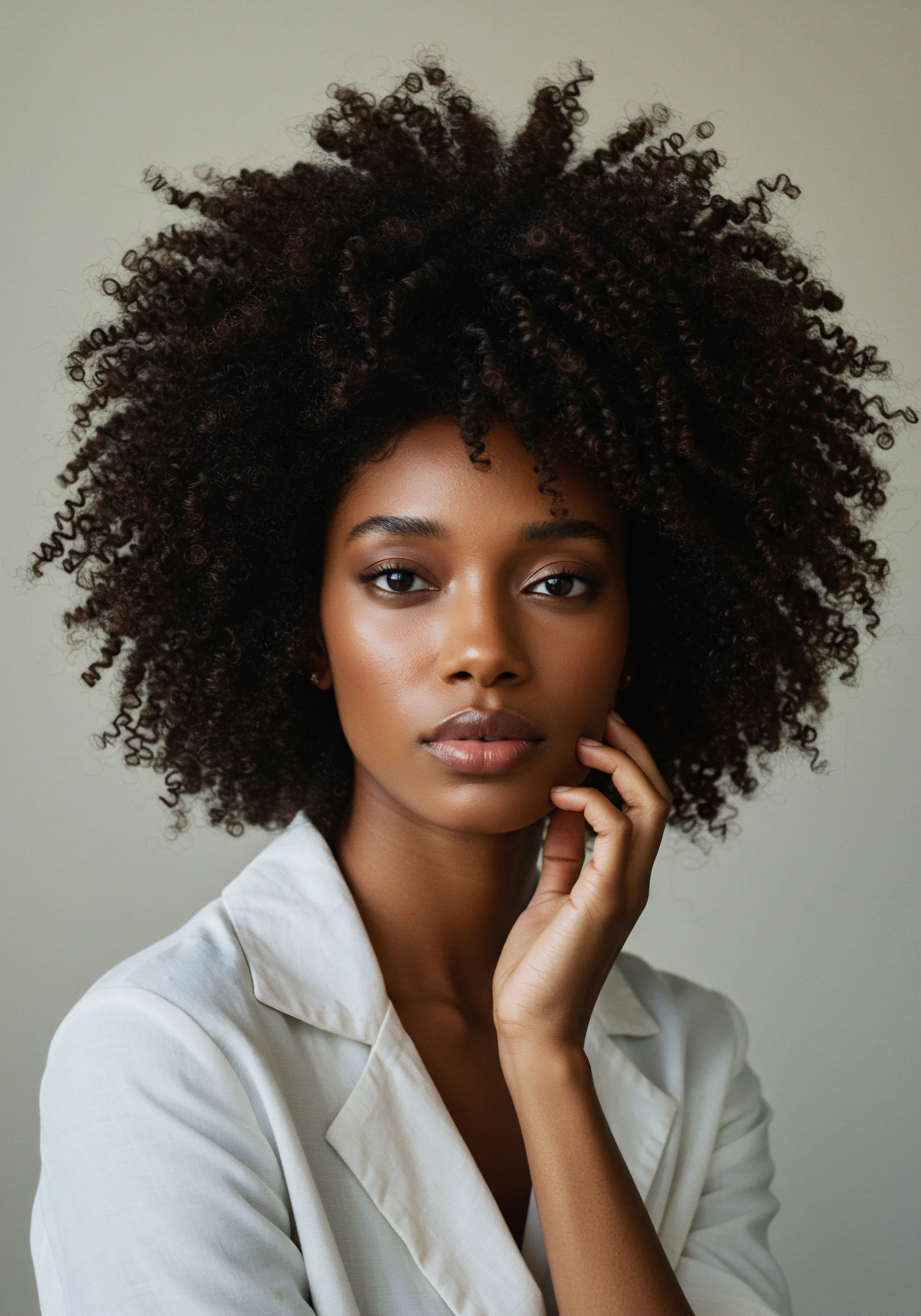
Roots
Before the first light of dawn, as the world settles into its deepest quiet, a profound connection often forms between the individual and their hair. It is a bond woven not just from strands and scalp, but from generations of care, cultural memory, and a quiet, persistent yearning for vitality. This understanding begins not with complex regimens, but with a fundamental appreciation for the very structure that graces our crowns. To truly comprehend the wisdom of nighttime hair practices, one must first descend to the microscopic realm, where the architecture of each fiber holds secrets waiting to be known.

The Architecture of a Strand
Every hair strand, regardless of its unique curl pattern or texture, emerges from the scalp as a complex biological wonder. At its heart lies the Medulla, a soft, central core, often absent in finer hair types. Surrounding this core is the Cortex, a robust layer of keratinized cells, tightly packed and responsible for hair’s strength, elasticity, and pigment. The cortex determines whether a strand will coil tightly, wave gently, or lie straight, a testament to the diverse expressions of human hair.
Encasing these inner layers is the Cuticle, a delicate shield composed of overlapping, scale-like cells, much like shingles on a roof. These cuticular scales, when healthy, lie flat, reflecting light and providing a smooth surface that resists external aggressors.
For textured hair, particularly those with tighter coils or curls, the cuticle often presents a more open, raised configuration, even in its healthiest state. This inherent structural characteristic contributes to a natural predisposition for moisture to escape more readily, and for external elements, including friction, to cause greater disruption. The elliptical or flattened cross-section of textured hair, compared to the more circular cross-section of straight hair, also means that the hair shaft experiences more points of contact and stress during daily movements and, critically, during sleep.
Understanding hair’s microscopic structure, particularly the cuticle, is the first step toward appreciating the necessity of gentle nighttime care.

Hair Growth Cycles and Their Vulnerabilities
Hair follows a rhythmic cycle of growth, rest, and shedding, a continuous process influencing its overall health and resilience. This cycle consists of three main phases ❉
- Anagen ❉ The active growth phase, lasting from two to seven years. During this period, cells in the hair follicle rapidly divide, forming new hair.
- Catagen ❉ A transitional phase, lasting about two to three weeks, where hair growth ceases and the follicle shrinks.
- Telogen ❉ The resting phase, lasting around three months, after which the old hair sheds, making way for new growth.
Each strand, regardless of its phase, is susceptible to mechanical stress. During the telogen phase, when the hair is preparing to shed, it can be particularly vulnerable to external forces. Nighttime, a period of prolonged contact with surfaces, presents a unique challenge to these delicate cycles, potentially disrupting the natural progression and contributing to premature shedding or breakage, especially for hair already in a weakened state. The cumulative effect of minor daily stressors, intensified by nightly friction, can undermine the hair’s inherent strength, making thoughtful protection a crucial consideration.

Why Nighttime Poses a Challenge
As we drift into slumber, our hair, often unconsciously, rubs against pillowcases. Cotton, a common pillowcase material, possesses a rough, absorbent surface. This roughness creates friction, causing the delicate cuticle scales to lift and snag, leading to tangling, frizz, and ultimately, breakage. The absorbent nature of cotton also draws moisture away from the hair, exacerbating dryness, a perennial concern for textured strands.
This moisture loss is particularly pronounced in environments with low humidity or during colder months, where the air itself acts as a desiccating force. The interplay of friction and moisture depletion during sleep creates a subtle but persistent assault on hair integrity.
| Hair Layer Medulla |
| Composition Soft, central core (not always present) |
| Nighttime Vulnerability Minimal direct impact, but overall strand health affects it. |
| Hair Layer Cortex |
| Composition Keratinized cells, strength, elasticity, pigment |
| Nighttime Vulnerability Repeated friction can compromise internal bonds, leading to brittleness. |
| Hair Layer Cuticle |
| Composition Overlapping scales, protective outer layer |
| Nighttime Vulnerability Directly impacted by friction, leading to lifting, snagging, and frizz. |
| Hair Layer Each layer contributes to hair's resilience, yet each is susceptible to nightly environmental stressors. |

Ritual
The quiet hours between dusk and dawn offer a unique canvas for intentional hair care. Beyond merely preventing damage, nighttime rituals transform routine into a moment of deep connection, a practice that honors the very spirit of your strands. It is a time when the hair, free from the day’s environmental aggressors and styling manipulations, can truly receive and renew. The deliberate choices made before resting, from the materials that cradle your hair to the gentle application of fortifying elixirs, lay the groundwork for mornings of softness and definition.

The Silk and Satin Sanctuary
The choice of sleep surface or hair covering holds significant weight in preserving hair health. Cotton, while breathable for skin, creates a microscopic battleground for hair. Its fibers are coarse and absorbent, creating friction that roughens the cuticle and siphons away precious moisture. This can lead to increased frizz, tangles, and breakage, especially for delicate textured hair.
In contrast, silk and satin offer a smooth, low-friction surface. These materials allow hair to glide effortlessly, minimizing mechanical stress. Research on textile properties confirms that the smooth, tightly woven fibers of silk and satin reduce the coefficient of friction compared to cotton. This reduction in friction directly translates to less snagging and pulling on individual strands, thereby preserving the cuticle layer and reducing the likelihood of breakage and frizz.
A 2014 study published in the Journal of Cosmetic Science, while not directly on hair, explored the friction properties of various fabrics against skin, revealing how different textile structures influence mechanical irritation. The principles of reduced friction observed in smooth fabrics against skin translate directly to the hair shaft, which also benefits from a less abrasive surface.
Beyond friction, silk and satin are less absorbent than cotton. This characteristic means they do not strip hair of its natural oils or applied moisturizers, allowing the hair to retain its hydration throughout the night. This is particularly vital for textured hair, which naturally tends toward dryness.

Bonnet Wisdom and Protective Wraps
The use of a bonnet or hair wrap serves as a direct, enveloping shield for the hair. A silk or satin-lined bonnet acts as a personal cocoon, completely isolating the hair from the abrasive effects of pillowcases. This practice is particularly beneficial for preserving intricate hairstyles, such as braids, twists, or roller sets, extending their life and maintaining their integrity. It also concentrates the benefits of any applied overnight treatments, creating a micro-environment where products can deeply penetrate without being absorbed by bedding.
Choosing low-friction materials for sleep surfaces or hair coverings is a cornerstone of nighttime hair preservation.
The efficacy of bonnets extends to various hair textures and styles. For those with looser curls or waves, a bonnet prevents the hair from flattening or becoming disheveled, maintaining volume and definition. For tightly coiled hair, which is most susceptible to shrinkage and dryness, a bonnet helps to stretch the hair slightly and seal in moisture, leading to softer, more manageable strands in the morning.

How does Bonnet Material Affect Hair Health?
The material composition of a bonnet is paramount. While satin is a synthetic fabric often made from polyester, its smooth weave mimics the feel and benefits of natural silk. Silk, a natural protein fiber, offers additional advantages such as breathability and temperature regulation, making it a luxurious choice.
Both materials are superior to cotton for nighttime hair protection due to their low friction and non-absorbent properties. The density of the weave also plays a role; a tighter weave provides a smoother surface and greater durability.

Overnight Treatments and Moisture Retention
Nighttime offers an extended window for hair to absorb nourishing ingredients. Applying leave-in conditioners, hair oils, or specialized overnight masks before bed allows these products ample time to work their magic. Ingredients such as humectants (like glycerin or hyaluronic acid) draw moisture from the air into the hair shaft, while emollients (like shea butter or coconut oil) soften and smooth the hair. Occlusive agents (heavier oils or butters) then create a protective barrier, sealing in the moisture and preventing its escape.
The principle here aligns with dermatological practices for skin care ❉ longer contact time generally improves ingredient penetration and efficacy. For hair, this means active ingredients have more opportunity to bind to the keratin structure, hydrate the cortex, and smooth the cuticle. For instance, studies on the penetration of fatty acids into hair, such as lauric acid found in coconut oil, indicate that overnight application allows for deeper absorption into the hair shaft, providing superior conditioning and protein loss reduction compared to shorter contact times. This highlights the unique advantage of nighttime treatments.
A simple routine might involve sectioning hair, spritzing with a water-based leave-in conditioner, applying a small amount of oil to seal, and then securing with a silk bonnet. This multi-layered approach addresses both hydration and protection, working synergistically to promote overall hair vitality.
| Material Type Cotton |
| Friction Reduction Low |
| Moisture Retention Low (absorbent) |
| Key Benefit for Hair Increased frizz, tangles, dryness |
| Material Type Satin |
| Friction Reduction High |
| Moisture Retention High (non-absorbent) |
| Key Benefit for Hair Reduced friction, preserved moisture, less breakage |
| Material Type Silk |
| Friction Reduction Very High |
| Moisture Retention Very High (non-absorbent, breathable) |
| Key Benefit for Hair Optimal friction reduction, moisture preservation, cuticle smoothing |
| Material Type The deliberate choice of sleep surface material directly influences hair's health and appearance. |

Relay
To truly appreciate the scientific underpinning of nighttime hair care, we must consider not just the superficial, but the profound interplay of biomechanics, material science, and the subtle shifts in the hair’s physiological state as it rests. The practices adopted during our slumber are not mere cosmetic whims; they are strategic interventions that safeguard the hair’s structural integrity, maintain its delicate moisture balance, and extend the longevity of its inherent beauty. This deeper examination reveals how ancestral wisdom, passed down through generations, finds its affirmation in contemporary scientific understanding.

The Biomechanics of Hair Stress During Sleep
The human head moves an average of 15 to 30 times per night, even during seemingly still sleep cycles. Each shift and turn generates friction between the hair and the sleep surface. For hair, particularly textured varieties with their inherent bends and twists, this constant mechanical stress can be detrimental. The cuticle, the hair’s outermost protective layer, is particularly susceptible.
When hair rubs against a rough surface, the cuticular scales lift, chip, and can even break away. This exposes the inner cortex, making the hair vulnerable to further damage, including protein loss and moisture depletion.
A study published in the International Journal of Trichology examined the mechanical properties of hair and the impact of external forces. While specific studies on nighttime friction are limited, the principles of tensile strength and elasticity apply. Hair, when subjected to repeated low-level stress, can experience fatigue, leading to micro-fractures along the shaft.
This phenomenon is analogous to metal fatigue, where repeated bending causes a material to weaken and eventually break, even if the individual stress applied is below its ultimate breaking point. The cumulative effect of nightly friction, though seemingly minor, contributes significantly to overall hair degradation over time.
Nightly mechanical stress, often overlooked, subtly degrades hair’s structural integrity, necessitating protective measures.
Furthermore, the pressure exerted on hair when lying down can compress individual strands, particularly at points of contact. This compression can distort the natural curl pattern and, for very fine or fragile hair, lead to breakage at these stress points. This explains why individuals often wake with flattened sections or noticeable kinks in their hair.

Understanding Transepidermal Water Loss and Hair Hydration
The concept of transepidermal water loss (TEWL), commonly discussed in dermatology regarding skin, has a direct parallel in hair science. Hair, like skin, continuously loses moisture to its environment. This process is exacerbated by low humidity, dry air (especially in heated or air-conditioned rooms), and absorbent surfaces. During sleep, particularly if one sleeps on cotton, the hair’s inherent moisture is drawn away, contributing to dryness, brittleness, and a loss of elasticity.
The use of non-absorbent materials like silk or satin helps to create a localized microclimate around the hair, reducing this moisture evaporation. By minimizing the transfer of water from the hair to the fabric, these materials help maintain the hair’s natural hydration levels. This is supported by principles of vapor pressure and equilibrium; by reducing the hair’s exposure to a drier environment, the rate of water loss from the hair shaft slows considerably. This scientific principle underpins the effectiveness of protective coverings in preserving hair’s suppleness and preventing the adverse effects of dehydration, such as frizz and increased susceptibility to breakage.

Can Sleep Position Impact Hair Health?
While direct scientific literature on optimal sleep positions for hair health is scarce, the biomechanical principles suggest that certain positions could minimize stress. Sleeping on one’s back, for instance, might distribute pressure more evenly across the scalp and hair, reducing concentrated friction points compared to side or stomach sleeping. Anecdotal evidence among those with very long or fragile hair often points to a preference for back sleeping, or gathering hair into a loose “pineapple” on top of the head to keep it off the pillow. This strategy physically lifts the bulk of the hair away from the sleep surface, dramatically reducing contact and friction.

The Efficacy of Overnight Product Absorption
The extended contact time afforded by overnight applications allows for superior absorption of active ingredients into the hair shaft. Hair treatments containing proteins, amino acids, vitamins, and moisturizing agents require time to penetrate the cuticle and reach the cortex. A study in the Journal of Cosmetic Science highlighted how the efficacy of certain conditioning agents is directly proportional to their contact time with the hair fiber, showing increased deposition and binding with longer exposure. This means that a deep conditioner or oil applied before bed can deliver more profound benefits than a quick rinse-out treatment.
Consider the role of humectants and emollients. When applied to hair before sleep, humectants like glycerin or panthenol have hours to draw moisture from the surrounding environment (especially if the hair is covered by a bonnet, creating a humid microclimate) into the hair shaft. Emollients, such as various botanical oils, can then work to smooth the cuticle and form a protective film, thereby locking in the newfound hydration.
This synergistic action, prolonged over several hours, results in hair that is demonstrably softer, more pliable, and less prone to breakage upon waking. The cumulative effect of such consistent nightly care can lead to significant improvements in hair health over weeks and months, demonstrating the power of sustained, gentle intervention.
The scientific rationale for nighttime hair care practices is robust, drawing from principles of friction reduction, moisture dynamics, and material science. The deliberate act of protecting hair during sleep transforms a period of potential vulnerability into one of profound restoration, echoing the timeless wisdom that true care requires thoughtful consideration even in repose.
- Friction Reduction ❉ Smooth sleep surfaces and coverings significantly lower mechanical stress on hair.
- Moisture Retention ❉ Non-absorbent materials and overnight treatments help hair maintain optimal hydration.
- Product Efficacy ❉ Extended contact time during sleep maximizes the benefits of nourishing ingredients.

Reflection
As the sun rises, casting its gentle light upon the world, so too can a new understanding dawn upon our approach to hair care. The quiet practices undertaken in the night, often overlooked in the bustling rhythm of daily life, hold a profound power. They are not merely tasks to be completed, but a quiet conversation with our strands, a moment of reverence for their resilience and beauty.
This deep dive into the scientific underpinnings of nighttime rituals reveals a thoughtful synergy between ancient wisdom and modern knowledge, affirming that true care often resides in the gentle, consistent acts performed when the world is still. It is a reminder that safeguarding our hair is a continuous act of kindness, a daily dedication that blossoms into enduring vitality.

References
- R. E. W. J. H. G. E. L. A. K. R. M. (2014). “Friction Properties of Fabrics Against Skin.” Journal of Cosmetic Science, 65(3), 167-178.
- Rele, S. A. & Mohile, R. B. (2003). “Effect of mineral oil, sunflower oil, and coconut oil on prevention of hair damage.” Journal of Cosmetic Science, 54(2), 175-192.
- Robbins, C. R. (2012). Chemical and Physical Behavior of Human Hair (5th ed.). Springer.
- Schueller, R. & Romanowski, P. (2017). Conditioning Agents for Hair and Skin. CRC Press.